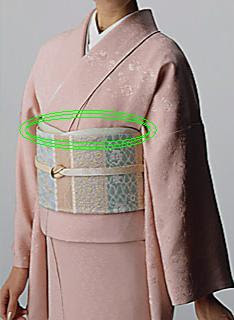Okay, I decided to skip the word of the week, cos I think that it's actually a little difficult to do that, particularly since all the nouns are taken up by "kimono item of the week" o_O So now, we're skipping straight to my kimono item of the week!
As promised, one of the obi that MAY match last week's kimono (though looking at it again, that may not be the case) - a nice black obi, with multi-coloured floral patterns!! Really beautiful piece. It cost me around US$20.50, and I had to fight abit for it, but I think it's really pretty and will match many of my things! Why, I even managed to pair it up with my green wool komon (one with a hemp leaves pattern on it), and that one is HARD to match! I do have another two obi that I'm bidding on, though - and I certainly hope I'll win the striped one! ^_^
Another kimono it can probably match is the white-based one with red tie-dye kiku and shibori on it. It may match my newest maroon kimono too, though I'm not too hopeful on that. I think it'll also go with the salmon pink wool kimono I bought from RyuJapan. Terrible thing, that site. The sales made me spend so much!! And it was
such a good deal I couldn't help myself! :P
*coughs* Now that I'm done with my ranting, onto the details! It's made of silk, and the patterns are embroidered on... A very nice length at 350cm, which is longer than usual, but given my fat body, the length will work nicely. Bought from kimono-wholesale on eBay. The colours are black (obviously) with olive green, purple, orange, red, two shades of blue.. I can't really state what specific colours there are, as I'm not sure myself!
*sigh* I really wish I hadn't forgotten to bring that book back with me.. It's called Kimono and the Colours of Japan and it's really good! It gives a list of colours and their names, and explains what people used to do in the past (and still do actually) to get that particular shade, for example dying the cloth yellow first then again with a raspberry red to get a rich shade of red. This is really good cos it helps me get the idea of what sort of colours will bring out the richness of any and every shade! A bonus would be all the little bits of info and history hidden amongst the text, and the kimono pictures used to demonstrate the colours. And for those who cannot read Japanese - fear not, for the texts are in both English and Japanese!
I cannot remember the name of the author, but this is one book every kimono enthusiast, or even textile enthusiast must have.















































